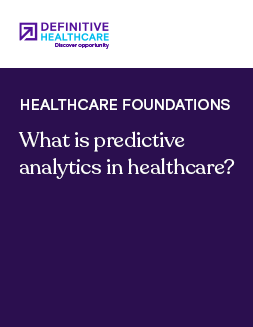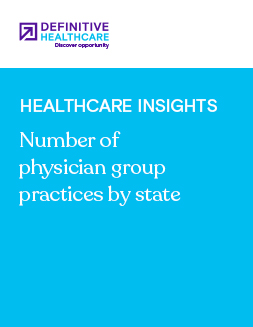Healthcare Insights
Patient care and procedure trends in cardiology by type of facility
According to the Centers for Disease Control and Prevention (CDC), heart disease is the leading cause of death for men, women, and most racial and ethnic groups in the United States. Additionally, the CDC reports heart disease costs the United States about $251 billion each year, along with $156 billion in lost productivity. With these staggering statistics, it’s clear that cardiac care is an essential service. Many healthcare provider organizations are focused on investing in cardiology service line growth and optimizing care for this population. To make the right decisions for your organization, staying on top of the top trends in cardiology is key.
Trends in cardiology: Five-year procedure growth by facility type
Using data from the Definitive Healthcare Atlas All-Payor Claims product, we examined growth in cardiology procedures from 2018 to 2023. Understanding trends in procedures is important for healthcare provider organizations with strategic initiatives including resource allocation, financial planning, improving quality of care, optimizing locations and services, and informing investments.
The following table lists the five-year growth in cardiology procedures across different types of healthcare organizations.
| Rank | Firm type | Cardiology procedure growth (2018-2023) | Market share | Market share change | Explore dataset |
|---|---|---|---|---|---|
| 1 | Retail clinic | 211.06% | 0.00% | 0.00% | Explore |
| 2 | Ambulatory surgery center | 21.58% | 0.80% | 0.21% | Explore |
| 3 | Urgent care clinic | 8.62% | 1.19% | 0.21% | Explore |
| 4 | Federally qualified health center | 2.07% | 2.95% | 0.37% | Explore |
| 5 | Assisted living facility | -0.88% | 0.02% | 0.00% | Explore |
| 6 | Hospital | -8.69% | 55.93% | 1.31% | Explore |
| 7 | ALL | -10.82% | 100.00% | 0.00% | Explore |
| 8 | Imaging center | -12.65% | 2.81% | -0.06% | Explore |
| 9 | Physician group | -14.94% | 35.44% | -1.72% | Explore |
| 10 | Rural health clinic | -22.18% | 0.70% | -0.10% | Explore |
| 11 | Renal dialysis facility | -24.91% | 0.03% | -0.01% | Explore |
| 12 | Hospice | -27.92% | 0.00% | 0.00% | Explore |
| 13 | Skilled nursing facility | -59.62% | 0.06% | -0.08% | Explore |
| 14 | Home health agency | -68.47% | 0.02% | -0.04% | Explore |
| 15 | Specialty pharmacy | -75.27% | 0.04% | -0.11% | Explore |
Fig. 1 Analysis of data from the Definitive Healthcare Atlas All-Payor Claims product representing physician-to-physician referral claims for January 2018 – December 2023. Claims data is sourced from multiple medical claims clearinghouses in the United States and updated monthly. Data accessed June 2024.
Shift to ambulatory care
As depicted in the table above, there is a fairly dramatic distribution of growth, particularly in retail clinics and ambulatory surgery centers. The following section lays out possible explanations for this.
Only three organization types had growth in cardiology procedures in the last five years. Interestingly, three other organizations types also saw at least some growth in market share, despite demonstrating negative procedure growth over the five-year period.
All three of the organization types that saw procedure growth deliver care in ambulatory settings, which is consistent with the macro trend of patient care shifting to outpatient settings. Ambulatory care can have several benefits for patients, payors, and providers, including faster access, shorter stays, and lower costs. There is also more opportunity for shared-equity ownership models for physicians in ambulatory sites.
However, procedure growth isn’t everything. Hospitals saw the greatest growth in overall market share, suggesting traditional care facilities are unlikely to lose their dominant position in the market anytime soon.
Which organization types have the highest percentage of cardiology procedure growth?
First on the list are retail clinics with a dramatic 211% growth in the last five years—10 times more than the second-place facility type (ASCs). Exploring some of the drivers to such growth, a contributing factor to this increase may be that cardiovascular disease screenings are increasingly attainable in outpatient clinic settings. This is reflected in the next highest procedure growth categories: ambulatory surgery centers (ASCs; 21.5% growth), urgent care clinics (8.6% growth), and Federally Qualified Health Centers (FQHCs; 2% growth).
While these categories represent the highest procedure growth over the five-year period, the change in market share over the same period doesn’t perfectly match that growth.
As mentioned, hospitals saw 1.3% growth in overall market share, the greatest market share growth among all facility types. FQHCs and ASCs tied for the next greatest share increase at 0.2%. While hospitals and physician groups collectively represent more than 91% of total cardiology procedure market share, FQHCs are the next largest category with nearly 3% of the market.
FQHCs are community-based organizations that receive funds from the Health Resources & Services Administration (HRSA) to provide primary care services to underserved and rural communities.
One driver contributing to the growth in FQHCs may be social determinants of health (SDOH). According to a research letter published in the Journals of the American College of Cardiology (JACC), racial and socioeconomic disparities in cardiovascular access significantly contribute to negative clinical outcomes. There has been a growing focus on addressing SDOH and health equity because SDOH has been shown to have a greater impact on health than genetic or access factors. The five-year growth trend in market share at FQHCs may suggest some progress toward providing more cardiology services to these underserved populations.
For example, the JACC research letter shares a retrospective study on a collaborative model between a FQHC and an academic medical center where a cardiology clinic was staffed on a volunteer basis by University of North Carolina (UNC) faculty cardiologists and medical students. The study found this collaboration was effective at reaching underserved cardiovascular patients.
Learn more
Healthcare Insights are developed with data from the Definitive Healthcare platform. Want even more insights? Start a free trial now and get access to the highest quality healthcare commercial intelligence on hospitals, physicians, and other healthcare providers.



